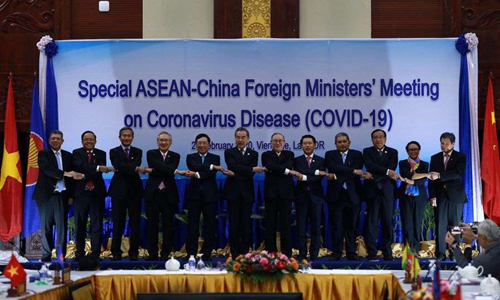HOME >> OPINION
China, ASEAN see interconnectivity strengthen
By Ding Gang Source:Global Times Published: 2020/3/18 17:43:40

Chinese State Councilor and Foreign Minister Wang Yi (L6) and foreign ministers of ASEAN countries attend the Special ASEAN-China Foreign Ministers' Meeting on Coronavirus Disease in Vientiane, Laos on Feb. 20. Photo: Xinhua
Since the COVID-19 outbreak, China-ASEAN relations have experienced changes that indicate closer ties are possible in the future.According to data released by the General Administration of Customs on March 7, ASEAN was China's largest trading partner in the first two months of 2020, ranking ahead of the EU and the US. The total trade value between China and ASEAN was 594.1 billion yuan ($84.6 billion), accounting for 14.4 percent of China's total foreign trade value, an increase of 1.6 percentage points over the same period last year.
There are four main reasons for the change. First, since the US-launched trade war against China, China-US trade has shown a downward trend, that is likely to continue for a long time. To offset the impact of the trade war, China and ASEAN have expanded bilateral trade.
The industrial ties between China and ASEAN have also been strengthened in the past few years. Many Chinese, Japanese, South Korean and other foreign companies have moved their factories in China to Vietnam, Malaysia and Thailand.
The expanded industrial chain was not carved off from China. The relocation of these factories to ASEAN hasn't led to the entire industrial chain moving to ASEAN countries. It is an extension of the industrial chain in China. The factories in ASEAN still need the support from Chinese factories for their raw materials, technology, spare parts and equipment. More importantly, many of their products are purchased by Chinese consumers. For example, many of the Transformer toys in Chinese stores are made in Vietnam, but the raw materials and processing machinery were made in China.
China's demand for agricultural products from ASEAN members has increased significantly. China is also the main source of tourists in ASEAN member states. Chinese tourists account for about 40 percent of all tourists in ASEAN. In 2019, the number of Chinese visitors to Thailand was 11 million.
Some Western scholars believe that after the pandemic, relevant enterprises and investors in ASEAN will adjust their previous dependence on China's industrial chain. However, what we are witnessing is a deeply integrated industrial chain between Chinese and ASEAN's companies, with the destination of many of the latter's products being the Chinese market. No other country can replace China in the short term. The region (ASEAN + China, Japan and South Korea) is still the main driving force of global economic growth and the manufacturing industry.
The pandemic has given us an opportunity to re-examine the problems in China-ASEAN relations. China and ASEAN member states still need to make higher level arrangements and strengthen cooperation in some major infrastructure projects. The China-proposed Belt and Road Initiative should be extended to areas related to local people's livelihood, such as healthcare systems.
Meanwhile, both sides will enhance emergency preparedness and boost information sharing and communication, especially in times of crisis, based on decisions made during the Special ASEAN-China Foreign Ministers' Meeting in February.
The pandemic has had a strong impact on the Southeast Asian economy and around the world. The main export destination for China and Southeast Asian products is the US and European markets. As China has been gradually resuming economic activities, its consumption needs will help the recovery of the Southeast Asia industrial sector. For instance, China can purchase Southeast Asian products as supplements to imports from other parts of the world.
The relationship between China and Southeast Asian countries has entered a new stage of in-depth coordination. Ties between countries in this region, driven by economic interconnection, will be closer in the future as coordination continues to strengthen. This will help form new trade and economic collaboration mechanisms, and create a significant impact on the pattern of international relations around the world.
The author is a senior editor with People's Daily, and currently a senior fellow with the Chongyang Institute for Financial Studies at Renmin University of China. dinggang@globaltimes.com.cn. Follow him on Twitter @dinggangchina
Posted in: ASIAN REVIEW